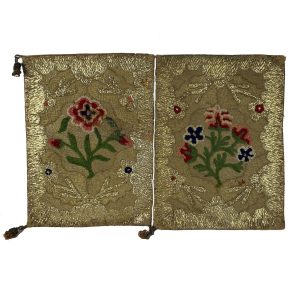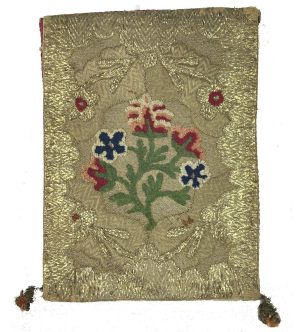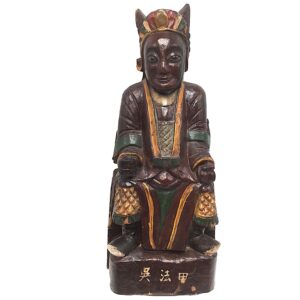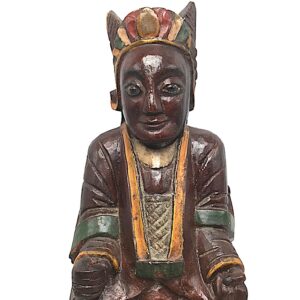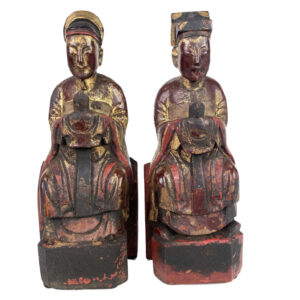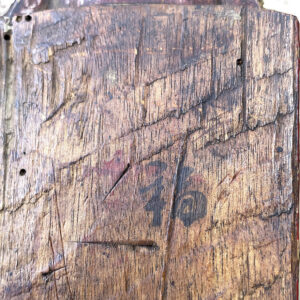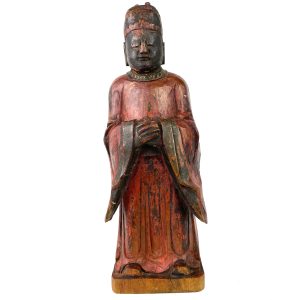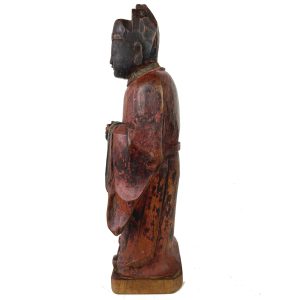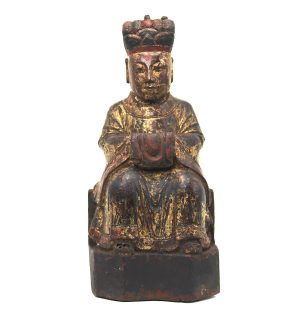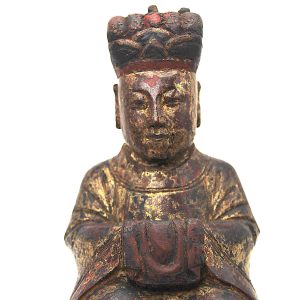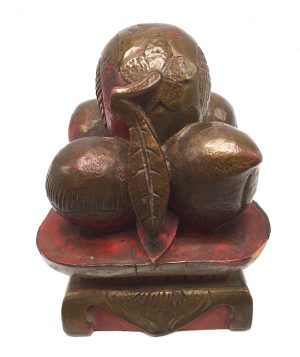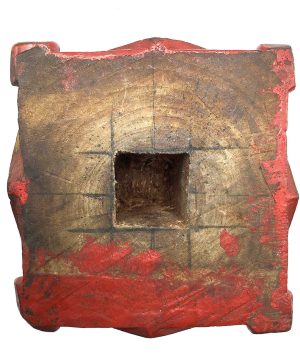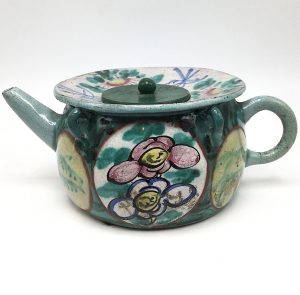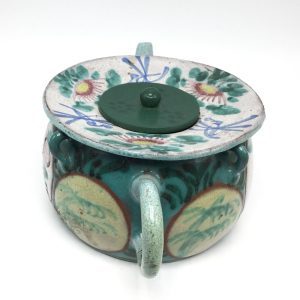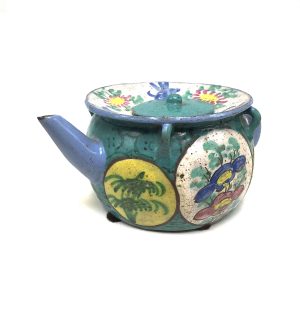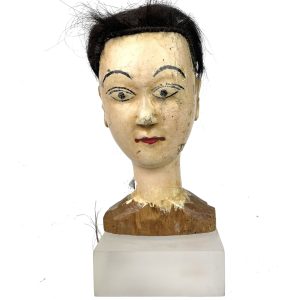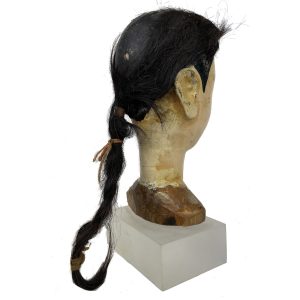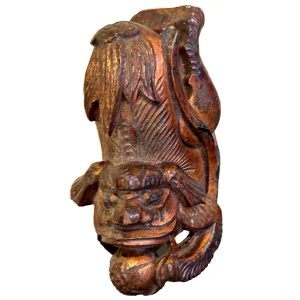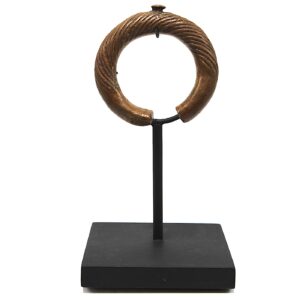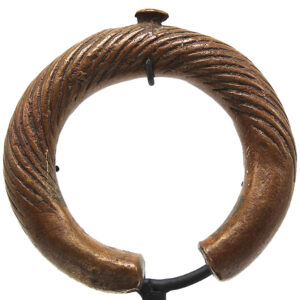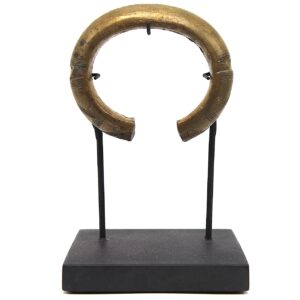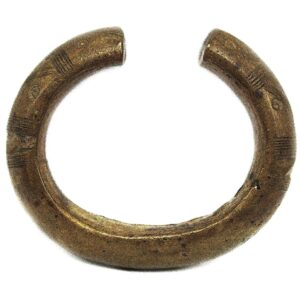Showing 13–24 of 89 results
-
Sale!


$185.00 Original price was: $185.00.$145.00Current price is: $145.00.
H: 3″ W: 10.5″ D: 0.5″ | FREE SHIPPING WITHIN CONTINENTAL U.S.
Bolivian religious document holder likely for priests’ sermons/important documents, brocaded purple fabric with gold thread of stylized passion flowers and roses representing Jesus’ crucifixion and purity .
-
Sale!


$325.00 Original price was: $325.00.$275.00Current price is: $275.00.
H: 12.75″ W: 3.375″ D: 3″ | FREE SHIPPING WITHIN CONTINENTAL U.S.
Either a Taoist house deity/dignitary or an ancestor figure, this colorful provincial carving has painted calligraphy identifying his name. The image has characteristics of Guandi, the God of War holding a tael or a military seal with military maille.
-
Sale!


$850.00 Original price was: $850.00.$650.00Current price is: $650.00.
H: 7.5″ W: 2.875″ D: 2″ | FREE SHIPPING WITHIN CONTINENTAL U.S.
VA’s most unique and finely crafted Kitchen God couple. Beautifully carved, clasping hu tablets, approachable features, smiling lips. Painted character on base wish for “happiness.” Add positive chi, enhance feng-shui.Unique house warming/wedding gifts.
-
Sale!


$425.00 Original price was: $425.00.$250.00Current price is: $250.00.
Ht: 8.25″ W: 3″ D: 2.125″ | FREE SHIPPING IN CONTINENTAL US
Ancestor figure portrayed as a civilian official standing on a rectangular base with hands together wearing a long civil official’s robe that extends to his shoes.
-
Sale!


$350.00 Original price was: $350.00.$250.00Current price is: $250.00.
H: 9.25″ W: 4.5″ D: 3.25″ | FREE SHIPPING WITHIN CONTINENTAL U.S.
Taoist official home altar carving painted on front and back with red, gilt and lacquer. Hands under ritual cloth symbolically holding a hu tablet associated with Taoist officials. Taoist were responsible for protecting against evil in this life, Buddhist for souls in next life.
-
Sale!


$225.00 Original price was: $225.00.$155.00Current price is: $155.00.
H: 4.75 ” Dia: 3.675 ” | FREE SHIPPING WITHIN CONTINENTAL U.S.
This carved food offering was an auspicious bed ornament to bring the lucky couple prosperity, health, a long life and many sons as the pomegranate symbolizes fertility, the peaches longevity. Carved offerings were often wedding gifts.
-
Sale!


$365.00 Original price was: $365.00.$295.00Current price is: $295.00.
H: 2.625” W: 6.125” D: 4” | FREE SHIPPING WITHIN CONTINENTAL U.S.
Small antique Yixing teapot with small loops below rim indicating may have been used to suspend oil or soy sauce. Hand painted vibrant enamels with circular panels of floral and leaf decorations.
-
Sale!


$365.00 Original price was: $365.00.$295.00Current price is: $295.00.
H: 2.6 ” W: 6.1 ” D: 4 ” | FREE SHIPPING WITHIN CONTINENTAL U.S.
Brightly hand- painted enamel with fanciful floral and leaf decorations, this small teapot a has circular loop handle, short spout, flaring rim and small flat cover. Although Yixing ware considered the best for brewing tea, antique pieces are for decorative and collecting purposes only.
-
Sale!


$295.00 Original price was: $295.00.$195.00Current price is: $195.00.
H: 8.5″ W: 4″ D: 2.75″ | FREE SHIPPING WITHIN CONTINENTAL U.S.!
Antique Chinese puppets were often made in several parts with removable heads. This antique carved head of a beauty has delicately painted features and an animal hair braided down the back. Since there is an area without hair towards the back, she likely originally wore a hat or headdress. A hole on top probably accommodated strings.
-
Sale!


$395.00 Original price was: $395.00.$295.00Current price is: $295.00.
Ht: 5″. W: 4″. D: 2.5″ | FREE SHIPPING WITHIN CONTINENTAL U.S.
Pair of red and gold antique carved lions were likely part of a woman’s bed frame to bless and protect its occupants. Each holds a spherical 5-leaf plums as wish for 5 Blessings of Happiness and for passing civilian official exams. Acrylic base.
-
Sale!


$165.00 Original price was: $165.00.$135.00Current price is: $135.00.
H: 2.875” W: 3” Thick: 0.625” Circum: 8.5” | FREE SHIPPING IN CONTINENTAL U.S.
Fine Fulani round manilla bracelet with parallel ridges over most of surface resembling a twisted metal pieces, topped with extended flat boss/knob in center.
-
Sale!


$185.00 Original price was: $185.00.$145.00Current price is: $145.00.
H: 2.75” W: 2.875” Thick: 0.5” Circum: 8.75” | FREE SHIPPING WITHIN CONTINENTAL U.S.
Antique thick metal manilla, smooth rounded outer surface with deeply etched and stamped traditional designs of triangles, horizontal bands, circles, facets and groves, flat ends. Excellent condition with fine patina.
End of content
End of content

